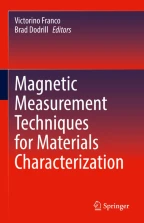Magnetic Field Sensing Techniques

We provide an overview of some of the most widely used magnetic field sensing techniques: Hall sensors, fluxmeters, fluxgates, anisotropic magnetoresistive (AMR) and giant magnetoresistive (GMR) sensors, and nuclear magnetic resonance (NMR) magnetometers. For each technology, we summarize the history, principle of operation, benefits and limitations, typical applications, key specifications, and recent developments. We conclude with an overview of magnetometer calibration, from the definition of magnetic field units to practical considerations.
This is a preview of subscription content, log in via an institution to check access.
Subscribe and save
Springer+ Basic
€32.70 /Month
- Get 10 units per month
- Download Article/Chapter or eBook
- 1 Unit = 1 Article or 1 Chapter
- Cancel anytime
Buy Now
Price includes VAT (France)
eBook EUR 74.89 Price includes VAT (France)
Softcover Book EUR 94.94 Price includes VAT (France)
Hardcover Book EUR 158.24 Price includes VAT (France)
Tax calculation will be finalised at checkout
Purchases are for personal use only

Magnetic Sensors
Chapter © 2021

Magnetic Sensors
Chapter © 2021

Magnetic Fields and Measurements
Chapter © 2021
References
- L. Bottura (2002) Field Measurement Methods. Presentation at CERN Accelerator School (CAS) on Superconductivity, Erice, May 8–17, 2002. http://m.home.cern.ch/m/mtauser/www/archives/events/erice/MM.pdf. Accessed 12.03.2007
- A. Grosz, V. Mor, E. Paperno, et al., Planar hall effect sensors with Subnanotesla resolution. IEEE Magn. Lett. 4 (2013). https://doi.org/10.1109/LMAG.2013.2276551
- R.S. Popovic, Hall Effect Devices, 2nd edn. (Institute of Physics Publishing, Bristol and Philadelphia, 2004) BookGoogle Scholar
- J. Dauber, A.A. Sagade, M. Oellers, et al., Ultra-sensitive hall sensors based on graphene encapsulated in hexagonal boron nitride. Appl. Phys. Lett. 106 (2015) https://arxiv.org/pdf/1504.01625.pdf. Accessed 10.08.2019
- University of Nebraska-Lincoln, Department of Physics and Astronomy (2019) Historical Scientific Instrument Gallery—Magnetism. https://www.unl.edu/physics/historical-scientific-instrument-gallery/magnetism. Accessed 25.07.2019
- E. Steingroever, G. Ross, Magnetic Measurement Techniques (MAGNET-PHYSIK Dr. Steingroever GmbH, Köln, 2008) Google Scholar
- L. Walckiers (1992) The Harmonic-Coil Method. Proceedings of the Magnetic measurement and alignment workshop, Montreux 1992, pp. 138–166. https://cds.cern.ch/record/245405/files/p138.pdf. Accessed 25.07.2019
- G. le Bec, J. Chavanne, C. Penel (2001) Stretched-wire measurements of multipole magnets at the ESRF. Presented at IMMW 17, ALBA, Barcelona, Spain, Sep 2011. https://public.cells.es/workshops/immw17.cells.es/presentations/Thu01-IMMW17-LeBec.pdf. Accessed 25.07.2019
- K. Evans, Fluxgate Magnetometer Explained—Mar. 2006 (Invasens, Cheltenham, 2006) http://invasens.co.uk/FluxgateExplained.PDF. Accessed 26.07.2019 Google Scholar
- Texas Instruments (2016) DRV425 Fluxgate Magnetic-Field Sensor. http://www.ti.com/lit/ds/symlink/drv425.pdf. Accessed 26.07.2019
- Korepanov V, Marusenkov A (2008) Modern Flux-Gate Magnetometers Design. In proceedings of International Scientific Conference on Magnetism—Geomagnetism—Biomagnetism MGB—2008, Sežana, Slovenija, Nov 7–8 2008, pp. 31–36. http://www.viviss.si/download/viviss/ZBORNIK%20MGB/Korepanov_paper_31_36.pdf. Accessed 26.07.2019
- R.P. Hunt, A magnetoresistive readout transducer. IEEE Trans. Magn. 6(1), 150–154 (1971) https://www.researchgate.net/publication/3109306_A_Magnetoresistive_Readout_Transducer. Accessed 07.08.2019 ArticleGoogle Scholar
- Measurement Specialties, Inc. (2017) Basics of Magnetoresistive (MR) Sensors. https://www.te.com/content/dam/te-com/documents/sensors/global/basics-magnetoresistive-mr-sensors-white-paper.pdf. Accessed 07.08.2019
- M.J. Caruso, T. Bratland, C.H. Smith, et al. (1998) A New Perspective on Magnetic Field Sensing. https://aerospace.honeywell.com/en/~/media/aerospace/files/technical-articles/anewperspectiveonmagneticfieldsensing_ta.pdf. Accessed 07.08.2019
- C.H. Smith, R.W. Schneider (1999) Low-Field Magnetic Sensing with GMR Sensors. Presented at Sensors EXPO, Baltimore, USA, May, 1999. https://www.nve.com/Downloads/lowfield.pdf. Accessed 08.08.2019
- N.A. Stutzke, S.E. Russek, D.P. Pappas, et al., Low-frequency noise measurements on commercial magnetoresistive magnetic field sensors. J. Appl. Phys. 97(10Q107) (2005) https://ws680.nist.gov/publication/get_pdf.cfm?pub_id=31842. Accessed 10.08.2019
- A.P. Ramirez, Colossal magnetoresistance. J. Phys. Condens. Matter 9(39), 8171–8199 (1997) https://iopscience.iop.org/article/10.1088/0953-8984/9/39/005. Accessed 10.08.2019 ArticleCASGoogle Scholar
- S.A. Solin, T. Thio, D.R. Hines, et al., Enhanced room-temperature geometric magnetoresistance in inhomogeneous narrow-gap semiconductors. Science 289, 1530–1532 (2000) http://www.ruf.rice.edu/~rau/phys600/ERM21.pdf. Accessed 09.08.2019 ArticleCASGoogle Scholar
- P. Keller, NMR magnetometers. Magn. Technol. Int. 2011, 68–71 (2011) https://www.ukimediaevents.com/publication/9c6782fc. Accessed 10.08.2019 Google Scholar
- Bureau International des Poids et Mesures (2019) Information for users about the redefinition of the SI. https://www.bipm.org/utils/common/pdf/SI-statement.pdf. Accessed 06.08.2019
- R.B. Goldfarb, The permeability of vacuum and the revised international system of units. IEEE Magn. Lett. 8, 1–3 (2017) https://ieeexplore.ieee.org/stamp/stamp.jsp?tp=&arnumber=8241772. Accessed 06.08.2019 ArticleGoogle Scholar
- H. Harcken (2011) MNPQ-Projekt: Ein neuartiges kompensiertes Spulensystem für die Messung magnetischer Momente mit geringem Streufeldeinfluss und die streufeldarme Erzeugung magnetischer Felder. https://www.ptb.de/cms/fileadmin/internet/fachabteilungen/abteilung_2/2.5_halbleiterphysik_und_magnetismus/2.51/KompSpule.pdf. Accessed 06.08.2019
- Committee on Data for Science and Technology (CODATA). http://www.codata.org. Accessed 06.08.2019
- NIST, Physical Measurement Laboratory, Fundamental Physical Constants. https://www.nist.gov/pml/fundamental-physical-constants. Accessed 06.08.2019
- P. Keller (2017) Values of Gyromagnetic Ratios. https://www.metrolab.com/wp-content/uploads/2018/07/Values-of-Gyromagnetic-Ratios-04.07.2018.pdf. Accessed 06.08.2019
- F. Bergsma (2003) Calibration of Hall sensors in three dimensions. Presented at IMMW13, SLAC, May 19–22, 2003. https://cds.cern.ch/record/1072471/files/cer-002727968.pdf. Accessed 06.08.2019
Author information
Authors and Affiliations
- Metrolab Technology S.A., Plan-les-Ouates, Geneva, Switzerland Philip Keller
- Philip Keller
You can also search for this author in PubMed Google Scholar
Corresponding author
Editor information
Editors and Affiliations
- Department of Condensed Matter Physics, University of Seville, Seville, Spain Victorino Franco
- Lake Shore Cryotronics, Westerville, OH, USA Brad Dodrill
Rights and permissions
Copyright information
© 2021 Springer Nature Switzerland AG
About this chapter
Cite this chapter
Keller, P. (2021). Magnetic Field Sensing Techniques. In: Franco, V., Dodrill, B. (eds) Magnetic Measurement Techniques for Materials Characterization. Springer, Cham. https://doi.org/10.1007/978-3-030-70443-8_12
Download citation
- DOI : https://doi.org/10.1007/978-3-030-70443-8_12
- Published : 29 September 2021
- Publisher Name : Springer, Cham
- Print ISBN : 978-3-030-70442-1
- Online ISBN : 978-3-030-70443-8
- eBook Packages : Chemistry and Materials ScienceChemistry and Material Science (R0)
Share this chapter
Anyone you share the following link with will be able to read this content:
Get shareable link
Sorry, a shareable link is not currently available for this article.
Copy to clipboard
Provided by the Springer Nature SharedIt content-sharing initiative

